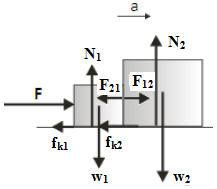1. Mass of the box 1 is 2 kg, the mass of the box 2 is 4 kg, acceleration of gravity is 10 m/s2, the magnitude of the force F is 40 Newton. The coefficient of the kinetic friction between the box 1 with the floor is 0.2 and the coefficient of the kinetic friction between the box 2 and floor is 0.3. Find (a) The magnitude and direction of the box’s acceleration (b) Magnitude of the force exerted by the box 1 on the box 2 (F12) and the magnitude of the force exerted by the box 2 on the box 1 (F21).

Solution

Known :
Mass of the box 1 (m1) = 2 kg
Mass of the box 2 (m2) = 4 kg
Acceleration of gravity (g) = 10 m/s2,
The force F = 40 Newton,
Coefficient of the kinetic friction between the box 1 with floor (μk1) = 0.2
Coefficient of the kinetic friction between the box 2 with floor (μk2) = 0.3
The weight of the box 1 (w1) = m1 g = (2)(10) = 20 Newton
The weight of the box 2 (w2) = m2 g = (4)(10) = 40 Newton
The normal force exerted on the box 1 (N1) = w1 = 20 Newton
The normal force exerted on the box 2 (N2) = w2 = 40 Newton
The force of the kinetic friction exerted on the box 1 (fk1) = (μk1)(N1) = (0.2)(20) = 4 Newton
The force of the kinetic friction exerted on the box 2 (fk2) = (μk1)(N2) = (0.3)(40) = 12 Newton
Solution :
(a) Magnitude and direction of the box’s acceleration
ΣF = m a
F – fk1 – fk2 = (m1 + m2) a
40 – 4 – 12 = (2 + 4) a
24 = 6 a
a = 24 / 6
a = 4 m/s2
Direction of the acceleration = direction of the net force = rightward.
(b) Magnitude of the force exerted by the box 1 on the box 2 (F12) and the magnitude of the force exerted by the box 2 on the box 1 (F21).
Calculate the magnitude of F12 :
ΣF = m a
F12 – fk2 = (m2) a
F12 – 12 = (4)(4)
F12 – 12 = 16
F12 = 16 + 12
F12 = 28 Newton
F12 and F21 are action and reaction forces that act on the different objects. F12 and F21 has the same magnitude and opposite direction.
F12 = 28 Newton = F21 = 28 Newton.
2. Mass of the box 1 is 2 kg, mass of the box 2 is 4 kg, acceleration of gravity is 10 m/s2, the force F is 40 N. The coefficient of the kinetic friction between the box 1 with the floor is 0.2 and the coefficient of the kinetic friction between box 2 and floor is 0.3. Determine (a) Magnitude and direction of the acceleration (b) The tension in the cord connecting the boxes. Ignore cord’s mass.

Known :
Mass of the box 1 (m1) = 2 kg
Mass of the box 2 (m2) = 4 kg
Acceleration of gravity (g) = 10 m/s2,
The force F = 40 Newton,
Coefficient of the kinetic friction between the box 1 with floor is 0.2 (μk1) = 0.2
Coefficient of the kinetic friction between the box 2 with floor is 0.2 (μk2) = 0.3
The weight of the box 1 (w1) = m1 g = (2)(10) = 20 Newton
The weight of the box 2 (w2) = m2 g = (4)(10) = 40 Newton
The normal force exerted on the box 1 (N1) = w1 = 20 Newton
The normal force exerted on the box 2 (N2) = w2 = 40 Newton
The force of the kinetic friction exerted on the box 1 (fk1) = (μk1)(N1) = (0.2)(20) = 4 Newton
The force of the kinetic friction exerted on the box 2 (fk2) = (μk1)(N2) = (0.3)(40) = 12 Newton
Solution :
(a) magnitude and direction of the acceleration
ΣF = m a
F – fk1 – fk2 = (m1 + m2) a
40 – 4 – 12 = (2 + 4) a
24 = 6 a
a = 24 / 6
a = 4 m/s2
Magnitude of the acceleration is 4 m/s2, direction of the acceleration = direction of the net force = rightward.
(b) Tension in the cord
Forces acts on the box 1 in the horizontal direction are the tension 1 (T1) rightward and force of the kinetic friction 1 (fk1) leftward. Apply Newton’s second law :
ΣF = m a
T1 – fk1 = m1 a
T1 – 4 = (2)(4)
T1 – 4 = 8
T1 = 8 + 4 = 12 Newton
The forces acts on the box 2 in the horizontal direction are the tension 2 (T2) leftward and force of the kinetic friction 2 (fk2) rightward. Apply Newton’s second law :
ΣF = m a
F – T2 – fk2 = m2 a
40 – T2 – 12 = (4)(4)
28 – T2 = 16
T2 = 28 – 16 = 12 Newton
The tension in the cord connecting the boxes = T1 = T2 = T = 12 Newton.
[wpdm_package id=’493′]
- Mass and weight
- Normal force
- Newton’s second law of motion
- Friction force
- Motion on horizontal surface without friction force
- Motion of two bodies with the same acceleration on rough horizontal surface with friction force
- Motion on inclined plane without friction force
- Motion on rough inclined plane with friction force
- Motion in an elevator
- Motion of bodies connected by cord and pulley
- Two bodies with the same magnitude of accelerations
- Rounding a flat curve – dynamics of circular motion
- Rounding a banked curve – dynamics of circular motion
- Uniform motion in a horizontal circle
- Centripetal force in uniform circular motion
